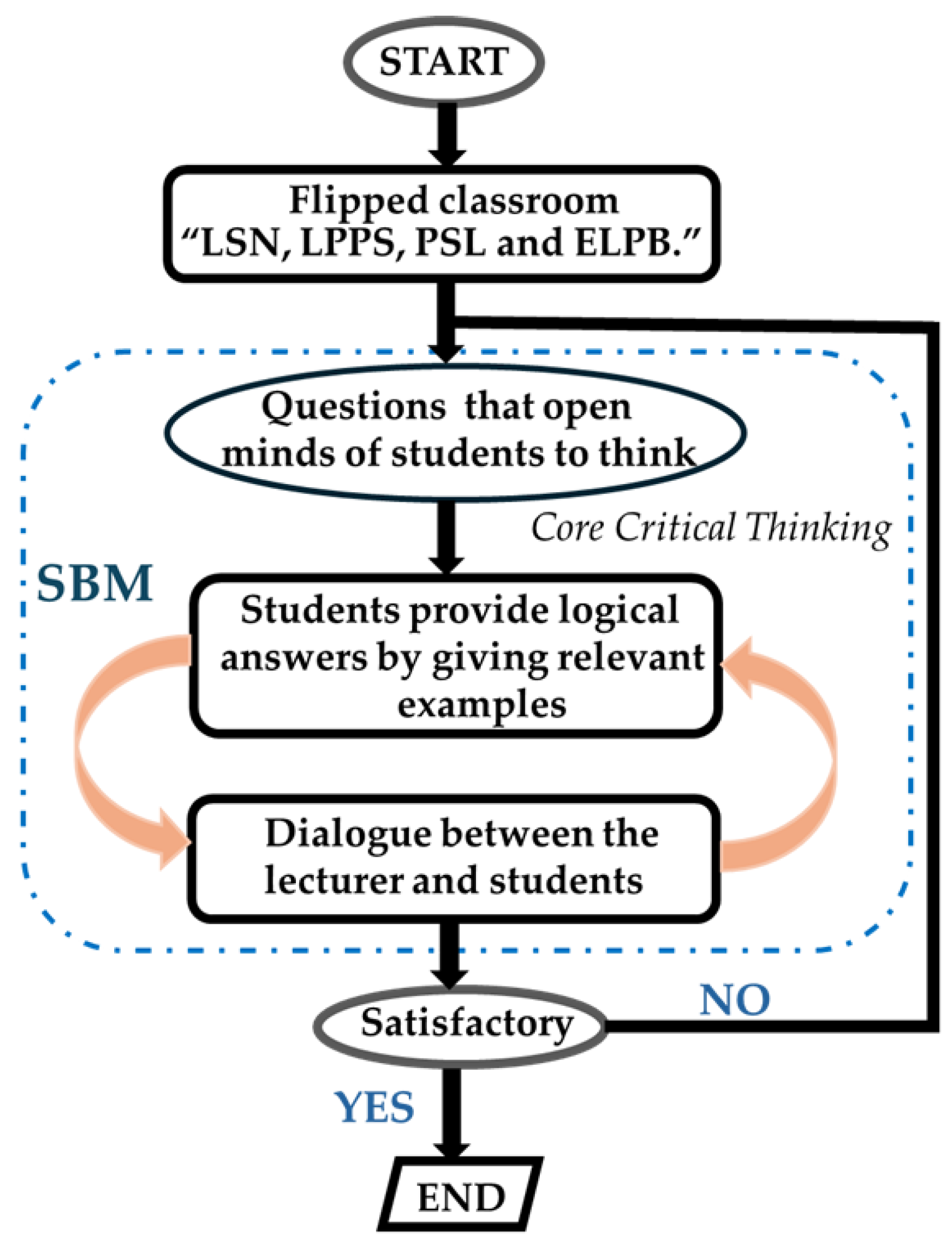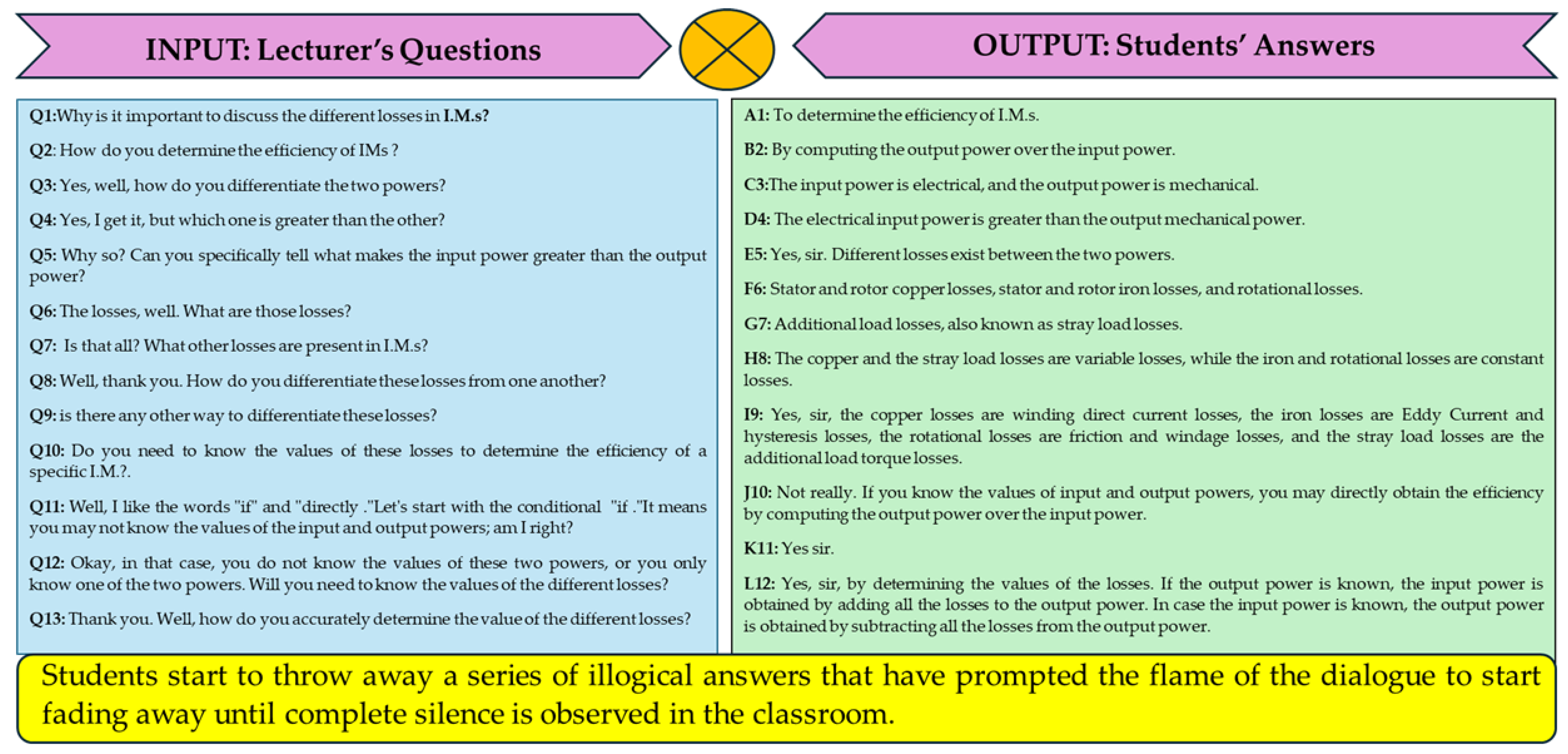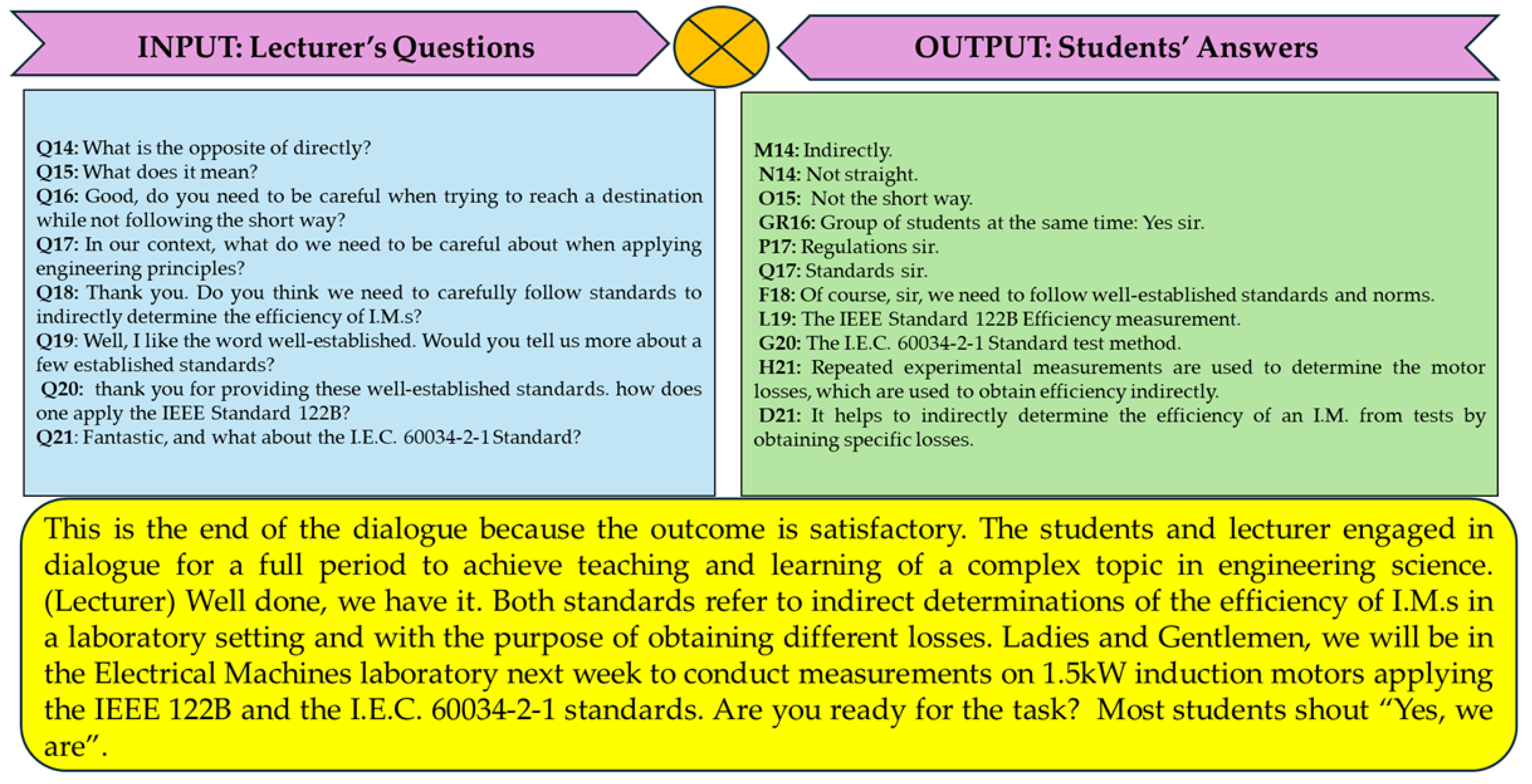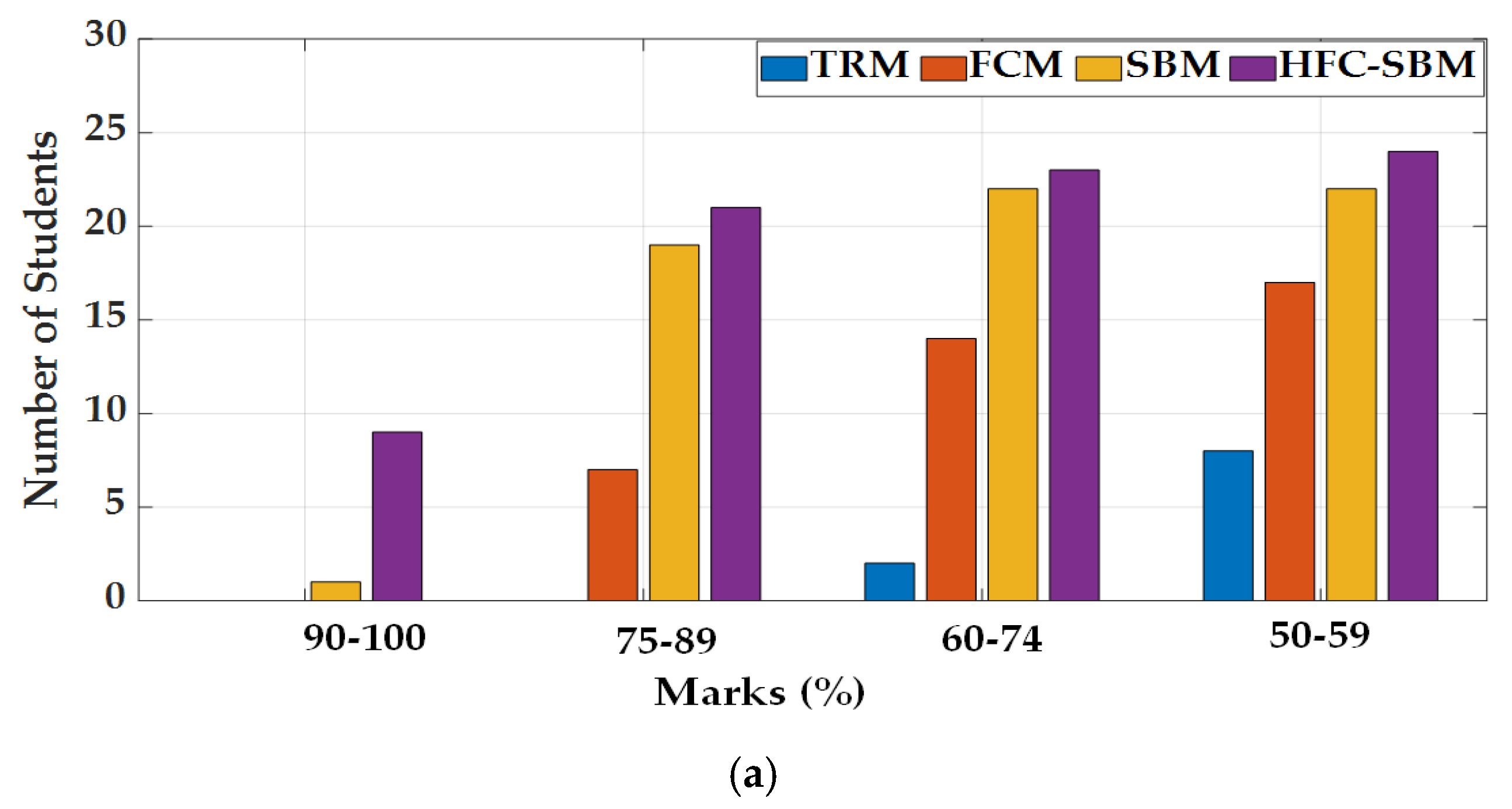Students’ Success Rate Enhancement in an Electrical Machines Subject Through a Hybrid Flipped Classroom–Socratic Method †
Abstract
1. Introduction
2. Materials and Methods
2.1. Materials
2.2. Approach
3. Results and Discussion
3.1. Analysis of Results
3.2. Analysis of Variance Experimental Test
4. Conclusions
Funding
Institutional Review Board Statement
Informed Consent Statement
Data Availability Statement
Conflicts of Interest
References
- Mehmet Akbaba, M. Teaching transient behavior of electrical machines with personal computers. Comput. Educ. 1997, 28, 155–164. [Google Scholar] [CrossRef]
- Bjekic, M.; Ricic, M.; Sucurovic, M. GeoGebra Tool: Development of Applications for Electrical Machines and Drives Teaching. Int. J. Eng. Educ. 2024, 40, 23–27. [Google Scholar]
- Bjekic, M.; Ricic, M.; Sucurovic, D. The Efficacy of GeoGebra Tool in Enhancing Electrical Machines and Drives Instruction. Int. J. Eng. Educ. 2024, 40, 38–42. [Google Scholar]
- Marmah, A.A. Students’ Perception About The Lecture As A Method Of Teaching In Tertiary Institutions. Views Of Students From College Of Technology Eduction, Kumasi (Coltek). Int. J. Educ. Res. 2014, 2, 601–612. [Google Scholar]
- Ambiyar, A.; Afifah, N. The Effect of Project Based Learning Towards Student Achievement in Electrical Machines and Energy Conversion Subject. J. Phys. Conf. Ser. 2019, 1387, 012087. [Google Scholar] [CrossRef]
- Čubela, D.; Rossner, A.; Neis, P. Using Problem-Based Learning and Gamification as a Catalyst for Student Engagement in Data-Driven Engineering Education: A Report. Educ. Sci. 2023, 13, 1223. [Google Scholar] [CrossRef]
- Kabilan, M.K.; Annamalai, N.; Chuah, K.-M. Practices, Purposes and Challenges in Integrating Gamification Using Technology: A Mixed-Methods Study on University Academics. Educ. Inf. Technol. 2023, 28, 14249–14281. [Google Scholar] [CrossRef] [PubMed]
- Sukackė, V.; Guerra, A.O.P.D.C.; Ellinger, D.; Carlos, V.; Petronienė, S.; Gaižiūnienė, L.; Blanch, S.; Marbà-Tallada, A.; Brose, A. Towards Active Evidence-Based Learning in Engineering Education: A Systematic Literature Review of P.B.L., P.J.B.L., and C.B.L. Sustainability 2022, 14, 13955. [Google Scholar] [CrossRef]
- Zare, J.; Aqajani Delavar, K. Enhancing English Learning Materials with Data-Driven Learning: A Mixed-Methods Study of Task Motivation. J. Multiling. Multicult. Dev. 2024, 45, 4011–4027. [Google Scholar] [CrossRef]
- Dicheva, D.; Dichev, C.; Agre, G.; Angelova, G. Gamification in Education: A Systematic Mapping Study. J. Educ. Technol. Soc. 2015, 18, 75–88. [Google Scholar]
- Novak, J.D.; Canas, A.J. The Theory Underlining Concept Maps and How to Construct and Use Them; Institute for Human and Machine Cognition: Pensacola, FL, USA, 2008. [Google Scholar]
- Vanides, J.; Yin, Y.; Tomiat, M.; Ruiz-Primo, M.A. Using concept maps in the Science Classroom. Sci. Scope 2005, 28, 27–31. [Google Scholar]
- Novak, J.D.; Gowin, D.B. Learning How to Learn; Cambridge University Press: New York, NY, USA, 1984. [Google Scholar]
- Alshatti, S.A.; Watters, J.J.; Kidman, G. Enhancing the teaching of family and consumer sciences: The role of graphic organizers. J. Fam. Consum. Sci. Educ. 2012, 28, 14–35. [Google Scholar]
- Wilgis, M.; McConnell, J. Concept mapping: An educational strategy to improve graduate nurses ‘critical thinking skills during a hospital orientation program. J. Contin. Educ. Nurs. 2008, 39, 119–126. [Google Scholar] [CrossRef] [PubMed]
- Caputi, L.; Blash, D. Teaching Nursing: Using Concept Maps; College of DuPage Press: Glen Ellyn, IL, USA, 2008. [Google Scholar]
- Halford, G.S. Children’s Understanding: The Development of Mental Models; Lawrence Erlbaum: Hillsdale, NJ, USA, 1993. [Google Scholar]
- Sarpparaje, M.; Jeyasala, V.R.; Rathiga, K.; Sasirekha, K. Flipped Classroom Approach to make the Best Utilization of E.S.L. Classes at Mepco Schlenk Engineering College-A Try Out. Asian ESP J. 2018, 14, 209–228. [Google Scholar]
- Khan, S.M. Facilitating Aural-oral skills of Engineering Students through the Flipped Classroom. TEST Eng. Manag. 2020, 82, 154–167. [Google Scholar]
- Delić, H.; Bećirović, S. Socratic Method as an Approach to Teaching. Eur. Res. Ser. A 2016, 10, 511–517. [Google Scholar]
- Boyle, J.; Nicol, D.; Bobby Hamilton, B.; Dempster, B. Experience with Classroom Feedback Systems to Enable Socratic Dialogue In Large Engineering Classes. In Proceedings of the IEE Engineering Education 2002: Professional Engineering Scenarios, London, UK, 3–4 January 2002. [Google Scholar] [CrossRef]
- Suhadi, S.M.; Zaid, N.M.; Mohamed, H.; Abdullah, Z.; Aris, B. Online learning” potential in Socratic learning methods to empower Higher Level Thinking. In Proceedings of the 2014 IEEE 6th Conference on Engineering Education (I.C.E.E.D.), Kuala Lumpur, Malaysia, 9–10 December 2014; pp. 145–150. [Google Scholar] [CrossRef]
- Suhadi, S.M.; Mohamed, H.; Zaid, N.M.; Abdullah, Z.; Aris, B.; Sanmugam, M. Implementation of Socratic Method in online learning to enhance creative thinking: Analysis review. In Proceedings of the 2016 4th International Conference on Information and Communication Technology (ICoICT), Bandung, Indonesia, 25–27 May 2016; pp. 1–4. [Google Scholar] [CrossRef]
- Chang, E.Y. Prompting Large Language Models with the Socratic Method. In Proceedings of the 2023 IEEE 13th Annual Computing and Communication Workshop and Conference (CCWC), Las Vegas, NV, USA, 8–11 March 2023; pp. 351–360. [Google Scholar] [CrossRef]
- Golanbari, M.; Garlikov, R. Employing Socratic Pedagogy to Improve Engineering Students’ Critical Reasoning Skills: Teaching by Asking Instead of by Telling. Am. Soc. Eng. Educ. 2008, 544. [Google Scholar]
- Montgomery, D.C. Design and Analysis of Experiments, 8th ed.; John Wiley & Sons: Hoboken, NJ, USA, 2013. [Google Scholar]
- Larson, M.G. Analysis of Variance. Circulation 2008, 117, 115–121. [Google Scholar] [CrossRef] [PubMed]
- Howell, D.C. Statistical Methods for Psychology, 7th ed.; Cengage Learning: Wadsworth, IL, USA, 2010. [Google Scholar]
- Wegner, T. Applied Business Statistics Methods and Excel-Based Applications, 4th ed.; Juta and Company Ltd.: Cape Town, South Africa, 2016. [Google Scholar]





| Scheme. | SS | df | MS | F | p-Value |
|---|---|---|---|---|---|
| Between Groups | P(F > F-crit) | ||||
| Within Groups | |||||
| Total |
| Source of Variance | SS | df | MS | F | p-Value | F-crit |
|---|---|---|---|---|---|---|
| Between Groups | 12,642.671 | 3 | 4,214.224 | 0.62 | 0.91 | 1.75 |
| Within Groups | 29,427.092 | 106 | 277.614 | - | - | - |
| Total | 42,069.763 | 109 | - | - | - | - |
Disclaimer/Publisher’s Note: The statements, opinions and data contained in all publications are solely those of the individual author(s) and contributor(s) and not of MDPI and/or the editor(s). MDPI and/or the editor(s) disclaim responsibility for any injury to people or property resulting from any ideas, methods, instructions or products referred to in the content. |
© 2025 by the author. Licensee MDPI, Basel, Switzerland. This article is an open access article distributed under the terms and conditions of the Creative Commons Attribution (CC BY) license (https://creativecommons.org/licenses/by/4.0/).
Share and Cite
Muteba, M. Students’ Success Rate Enhancement in an Electrical Machines Subject Through a Hybrid Flipped Classroom–Socratic Method. Eng. Proc. 2025, 104, 12. https://doi.org/10.3390/engproc2025104012
Muteba M. Students’ Success Rate Enhancement in an Electrical Machines Subject Through a Hybrid Flipped Classroom–Socratic Method. Engineering Proceedings. 2025; 104(1):12. https://doi.org/10.3390/engproc2025104012
Chicago/Turabian StyleMuteba, Mbika. 2025. "Students’ Success Rate Enhancement in an Electrical Machines Subject Through a Hybrid Flipped Classroom–Socratic Method" Engineering Proceedings 104, no. 1: 12. https://doi.org/10.3390/engproc2025104012
APA StyleMuteba, M. (2025). Students’ Success Rate Enhancement in an Electrical Machines Subject Through a Hybrid Flipped Classroom–Socratic Method. Engineering Proceedings, 104(1), 12. https://doi.org/10.3390/engproc2025104012






